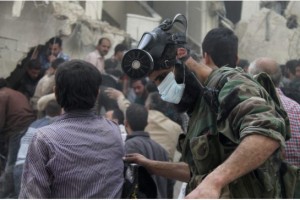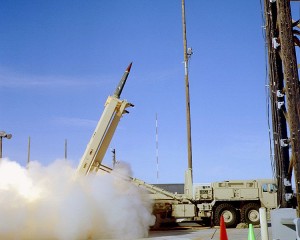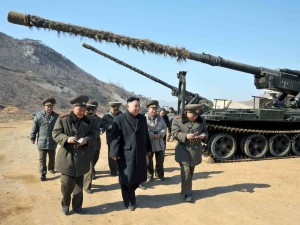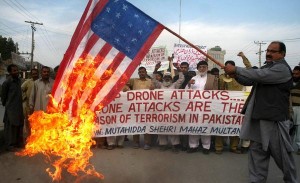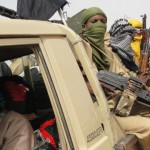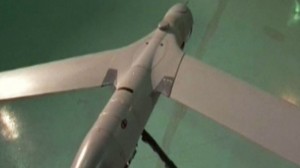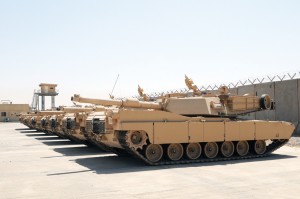
M1A1 Abrams tanks sit parked at a secured compound at the Besmaya Combat Training Center. The last shipment of M1A1 Abrams tanks arrived mid-August completing the Government of Iraq’s purchase of 140 tanks through a Foreign Military Sales agreement with the United States.
— Photo by Army Staff Sgt. Edward Daileg
INTRODUCTION
The mighty U.S. military industrial complex (MIC) continues to swell, particularly after two decade-long, trillion dollar wars and a post 9/11 world wrought with conflict. A 2012 CNBC report concluded that among the ten biggest U.S. government contractors, defense contractors secured a remarkable nine of the ten spots (Toscano, 2012). These mega-Fortune 500 companies rake in thousands of government contracts, totaling over a hundred billion dollars a year. Many of the contracts involve classified and or proprietary technological projects, making it very easy to monopolize markets and inflate costs. The Buy American Act (41 USC § 10a-d) further enables U.S. defense industry conglomerates to eliminate foreign competition and fix their grip on the market. With multi-billion dollar profits on the line, defense industries spare no expense employing powerful lawyers and lobbyists. The sheer size, scope and profitability of these corporations, courtesy of the taxpayer, make them popular investment opportunities for public and private citizens alike. The perpetual state of war and resultant profit-mongering raises concern about the actual role and or influence of the MIC in U.S. foreign and economic policy. President Dwight D. Eisenhower warned of a growing military industrial complex’s search for profits warping foreign policy and the traditional American way of life. Alas, half a century later we have yet to heed this warning.
EXPANDING U.S. WEAPONS SALES ABROAD: GOOD OR BAD FOR AMERICA?
The U.S. makes the best weapons and weapon countermeasure systems in the world. Its closest competitor, Russia, continues to suffer from aging technology and infrastructure, rampant corruption and decreasing demand for obsolete, legacy Soviet weaponry. According to 2011 estimates, the U.S. held roughly 75 percent of the global arms market with related output constituting just ten percent of all U.S. exports; thus, leaving some room for expansion in the midst of a weakening Russian market, struggling U.S. economy and a slew of simmering global conflicts (Shanker, 2012).
While U.S. government (USG) defense spending makes up, on average, only five percent of current GDP, this figure fails to capture this powerful industry’s influence on the greater economy and U.S. politics (O’Connell, 2012). The MIC has economic implications beyond government spending. The MIC employs millions of U.S. workers (many of which are highly skilled scientists and engineers); bolsters hundreds of smaller start-up companies/sub-contractors; engages in significant investments in high tech research and development and adds billions more to U.S. net exports (Kazmierczak 2007). Proponents of the MIC contend that reductions in defense spending would lead to thousands of Americans out of work; many companies shutting down; a sharp reduction in U.S. exports; a threat to America’s competitive edge in the technology industries, military influence and national security interests abroad (2007).
Proponents of the MIC also claim that USG support of military equipment sales expansion in a high-demand market could mean great things for U.S. GDP. However, is U.S. GDP more important than the implications of weapons proliferation in particularly volatile parts of the globe? The proliferation of advanced U.S. weapons systems in certain regions is sure to fuel an arms race and further escalate tensions during a particularly low point in U.S. foreign relations. There is also an increased risk of advanced weapons getting into the wrong hands. The Pentagon’s foreign military aid budgets remain significantly larger than State Department development budgets, leading one to ask whether today’s foreign policy goals are geared more toward securing military alliances than fostering good governance and stable economies abroad. Perhaps it is more about big business politics than spreading peace and stability? Is this push for profits over peace putting our nation at risk?
WHAT DOES THE OBAMA ADMINISTRATION THINK?
Faced with a struggling economy in the aftermath of four stimulus packages and two costly wars, President Obama’s economic team has struggled to find alternatives to the traditional Keynesian approach of increasing government borrowing to supplement consumer spending. In early 2010, the Obama team turned to another tool to boost GDP, net exports (Cooper, 2010). The National Export Initiative (NEI), a bold strategy focusing on doubling U.S. net exports by 2014, was unveiled during the 2010 State of the Union Address. While the exact terms of the plan remain somewhat elusive, one particular aspect of the strategy continues to generate controversy among counter proliferation circles. Specifically, many are skeptical about the easing of export controls on the sale and transfer of U.S. manufactured weapons and related dual-use commodities (Horwitz, 2012). This policy change suggests that the Obama administration hopes to capitalize on global demand for weapons and weapon countermeasures to help bolster net exports. This initiative also suggests a possible shift to a more big business friendly, supply-side economics approach whereby the U.S. government would offer special subsidies and relaxed regulations for defense industries, making it easier to sell abroad. This recent shift could ultimately stall, if not curtail, any hopes of securing peace and stability in the Middle East and East Asia.
WHAT DO THE NUMBERS SUGGEST?
Since initiating NEI, foreign sales of weaponry between 2010-2011 rose by $21.4 Billion to $66.1 Billion, marking the largest single-year sales total in the history of United States arms exports (Shanker, 2012). Below are few examples of major foreign weapons sales since 2010:
- Saudi Arabia – 84 advanced F-15 fighters for a record $29.4 billion deal, $1.7 billion in upgrades to its missile defense systems a variety of ammunition, missiles and logistics support, and upgrades of 70 of the F-15 fighters and dozens of Apache and Black Hawk helicopters, (Shanker, 2012 and Samaan, 2013).
- UAE – Sale of Terminal High Altitude Area Defense, an advanced antimissile shield that includes radars and is valued at $3.49 billion ($12 billion over four years), as well as 16 Chinook helicopters for $939 million (2012).
- Oman – 18 F-16 fighters jets for $1.4 billion (2012).
- Kuwait – $4.2 billion in weaponry, including 60 Patriot Advanced Capability missiles, 20 launching platforms and 4 radars (2012)
- India – 10 C-17 Globemaster III military transport aircraft, valued at approximately $4.1 billion and 107 F414 engines to be installed on the Tejas light combat aircraft valued at approximately $822 million (The White House, 2010).
- Japan – purchased for an unknown amount the U.S. Aegis missile defense system, as well as Standard Missile-3 (SM-3) IA interceptors, early-warning radars, and command and control systems (Cooper, 2010).
- Iraq – $6 billion for 32 F-16 fighter jets with $12 billion in additional deals pending
Pledges for Fiscal Year 2014:
- Israel – Increase in military aid from $2.4 to $3.1 billion, including $220 million for Israeli missile-defense systems (complementing the extant $460 million) (Samaan, 2013).
- UAE – $5 billion in F-16 fighter jets (2013).
- Egypt – 20 F-16 fighter jets and 200 advanced, M1A1 Abrams tanks as part of a multi-billion dollar aid package
The above data illustrates a major policy shift in military aid, particularly in East Asia and the Middle East. Clearly, the U.S. MIC has exploited NEI and fears of an Iranian or North Korean missile strike to secure multiple, multi-billion dollar sales. The recent spike in tensions throughout the Middle East and Korean peninsula provide a convenient catalyst for sustaining billion dollar arms deals as the wars in Iraq and Afghanistan wind down and U.S. defense budgets shrink (Zengerle, 2012). Some may even find it ironic that amid drastic cuts planned for the U.S. missile defense program, fears of a North Korean missile strike peaked, only to fizzle after new budget deals were reached and additional missile defense systems were rapidly deployed throughout the Western U.S. and Pacific Theater (Wong, 2013, Bell, 2013 and Stewart, 2013). Additionally, capitalizing on potential threats of an Iranian missile strike paved the way for multiple, multi-billion dollar arms deals with Israel, Egypt and many Arab countries tied to Western oil and gas markets (e.g. Qatar, Saudi Arabia, Oman, United Arab Emirates, Bahrain) (Shanker, 2012, Shalal-Esa, 2012 and Samaan, 2013). The ultimate question is whether this is the result of actual geopolitical events and legitimate threats, or a carefully scripted agenda to bolster U.S. influence in these regions, dominate the global arms trade market and secure significant profits for the MIC?
CONCLUDING THOUGHTS: WHAT’S GOOD FOR THE (FAT) GOOSE MAY NOT BE GOOD FOR THE GANDER
Keynesian economic theory suggests that government deficit spending is good policy for supplementing shortages in consumer spending, hinging on the dollar multiplier effect. When applying this theory, pumping billions into U.S. based industries should be good thing for the economy, right? Wouldn’t this provide a GDP boost from government spending, business expansion, greater investments in technology and more jobs?
There are two main issues with applying the Keynesian model to today’s struggling economy amid two wars. One problem is that the government spent money it did not have, merely shifting a larger economic crisis to future generations. The other key issue is that the MIC represents only a small fraction of U.S. industry and employment. The billions pumped into these war machines benefited only a small portion of the economy while constraining other economic sectors. The end result was little or no return on the borrowed dollar, thus no improvement for the economy in the short-term. This risky, short-sighted approach to doing business is strikingly similar to the very same practices which led to the recent financial collapse. Could this be yet another example of profit-grabbing corporate interests infiltrating government policy making?
When shifting to a supply-side or trickle-down economics approach, a similar outcome emerges. Special tax subsidies and relaxed export control regulations may enable the MIC to ship more products overseas and increase net exports, but the net benefits are still confined to a small portion of the economy. Ultimately, speculation that the USG is hedging its GDP boosting hopes on increased foreign sales of weapons systems does not hold water. Recent efforts to boost arms exports are more likely linked to political pandering than real economic reform. The MIC is most likely looking elsewhere to sustain and or boost short-term profits in the midst of drastic cuts to defense spending and using its powerful lobby to make it happen. The practice of letting these profit-based companies dictate U.S. policy, like President Eisenhower posited, poses enormous risks on the American way of life. Will the American people continue to let MIC profit seekers selfishly escalate global tensions under the guise of economic reform?
By Ryan Daniels
May 30, 2013
Works Cited:
Bell, Larry. (2013, March 24). Obama’s North Korean and Iranian Missile Defense Trajectories: Course Corrections; Russian Re-set Dud. Forbes. Retrieved from
Cooper, Helen. (2010, January 28). Obama Sets Ambitious Export Goal. The New York Times. Retrieved from http://www.nytimes.com/2010/01/29/business/29trade.html?_r=0
Entous, Adam and Julian E. Barnes. (2012 August 23). U.S. Plans New Asia Missile Defenses. Wall Street Journal. Retrieved from
http://online.wsj.com/article/SB10000872396390444812704577605591629039400.html
Horwitz, Sari. (2012 May 02). Obama Plan Would Ease Weapons Export Rules. The
Washington Post. Retrieved from
Kazmierczak, Matthew and Michaela Platzer. (2007 March). Defense Trade: Keeping America Secure and Competitive. A report prepared by: U.S. Chamber of Commerce.
Retrieved from http://www.uschamber.com/sites/default/files/issues/defense/files/defensetrade.pdf
O’Connell, Aaron B. (2012 November 4). The Permanent Militarization of America. The New York Times. Retrieved from http://www.nytimes.com/2012/11/05/opinion/the-permanent-militarization-of-america.html?pagewanted=all&_r=0
Samaan, Jean-Loup. (2013 May 10). U.S. Arms Sales All About Iran. Al-Monitor. Retrieved from http://www.al-monitor.com/pulse/originals/2013/05/us-arm-sales-iran.html
Shalal-Esa, Andrea. (2012 November 6). U.S. Clears Sale of Lockheed Missile Defense
System to UAE, Qatar. Reuters. Retrieved from
http://www.reuters.com/article/2012/11/06/us-lockheed-missiles-mideast-idUSBRE8A507J20121106
Shanker, Thom (2012 August 8). U.S. and Gulf Allies Pursue Missile Shield Against Iranian Attack. The New York Times. Retrieved from http://online.wsj.com/article/SB10000872396390444812704577605591629039400.html
Shanker, Thom (2012 August 26). U.S. Arms Sales Make up Most of Global Market. The New York Times. Retrieved from
http://www.nytimes.com/2012/08/27/world/middleeast/us-foreign-arms-sales-reach-66-3-billion-in2011.html
Stewart, Phil and David Alexander. (2013 March 16). U.S. to Bolster Missile Defenses to
Counter North Korea Threat: Hagel. Reuters. Retrieved from
http://www.reuters.com/article/2013/03/16/us-korea-north-usa-defense-idUSBRE92E0SV20130316
Thompson, Loren B. (2010 June 8). White House Export Goals Require More Weapons Sales. A Report Prepared by: The Lexington Institute. Retrieved from
http://www.lexingtoninstitute.org/white-house-export-goals-require-more-weapons-sales
Toscano, Paul and Jill Wineberger. (2012 June 13). The 10 Biggest U.S. Government Contractors. A report prepared by: CNBC news. Retrieved from
http://www.cnbc.com/id/42494839
Wong, Kristina. (2013 April). Pentagon Budget Ignores Sequester, Puts Off Cost-Saving. The Washington Times. Retrived from
Zengerle, Patricia. (2013 April 12). Congressman Who Made North Korea Nuclear Comment Opposes Missile Defense Cuts. Reuters. Retrieved from
http://www.reuters.com/article/2013/04/12/us-korea-north-usa-lamborn-idUSBRE93B14D20130412
